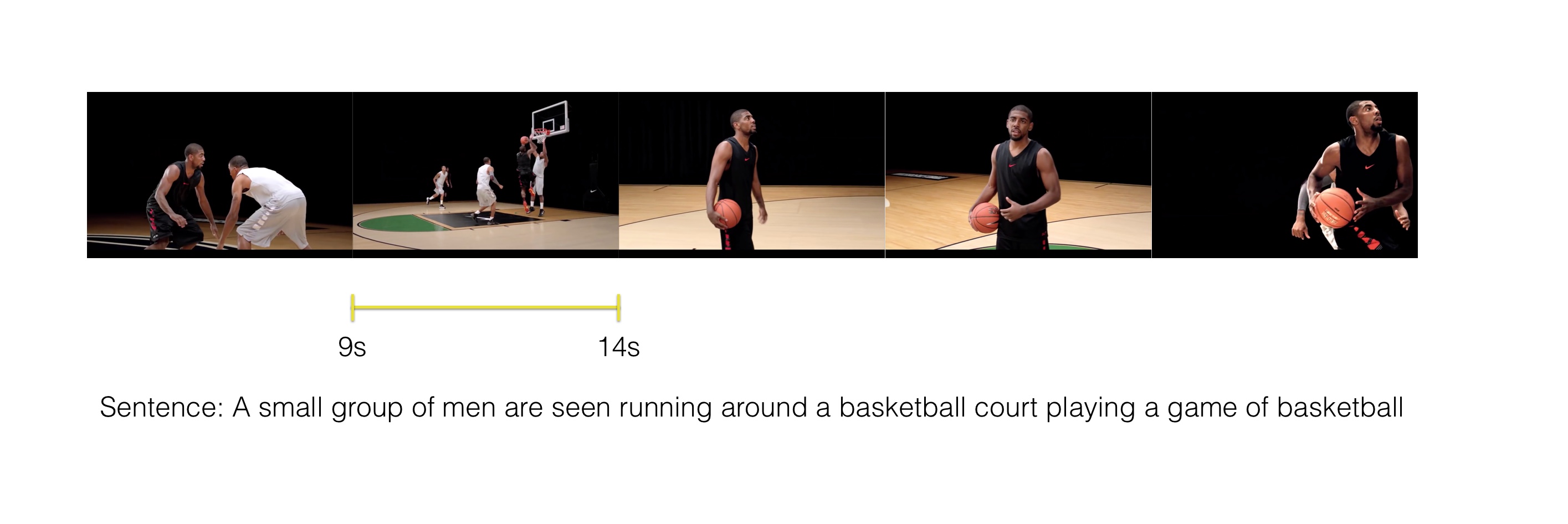Code for the paper Temporally Grounding Natural Sentence in Video [EMNLP 2018].
If you find this code useful, please consider citing the original work by authors:
@inproceedings{chen-etal-2018-temporally,
title = "Temporally Grounding Natural Sentence in Video",
author = "Chen, Jingyuan and
Chen, Xinpeng and
Ma, Lin and
Jie, Zequn and
Chua, Tat-Seng",
booktitle = "Proceedings of the 2018 Conference on Empirical Methods in Natural Language Processing",
month = oct # "-" # nov,
year = "2018"
}
This paper focuses on the task of Natural Sentence Grounding in Video (NSGV). Given an untrimmed video and a natural sentence, the model has to find a segment in the video with the same semantic content as the given sentence.
Prior work has addressed this task mostly by utilizing a temporal sliding window over the videos which is prohibitively slow [2][3]. Moreover, they project both the videos and captions into the same embedding space and use the generated vectors to match the segments in the videos with the captions. According to [1], this matching just considers the globbal relations between the textual and visual data. In order to sidestep these problems, this paper proposes Temporal GroundNet (TGN) as the first single-stream neural architecture for the task of NSGV. The following figure depicts the overview of the model:
In order to extract the fine-grained interactions between frames and words, TGN relies on an interactor which is a LSTM network (named iLSTM in the figure). The iLSTM computes a frame specific sentence representation for each frame. To be more specific, it gets the hidden states of the textual LSTM encoder and computes the following representation for the _t_th frame:
where h's are the hidden states of textual LSTM encoder and ⍺'s are the weights correpsonding to these hidden states. Please refer to the original paper to see how these weights are calculated. Note that the names of the variables in the code matches the symbols used by the paper. It is worth mentioning that the network goes through the video only once which leads to less computational cost comparing to previous work. The implementations of different components of the model can be found in the models directory. The code is documented well to leave no room for ambiguity.
You can install all of the required modules using the following command:
pip install -r requirements.txtThe original paper has evaluted the model on three datasets: DiDeMo, TACoS, and ActivityNet Captions. As the DiDeMo dataset is not publicly accessible anymore, I just considered TACoS and ActivityNet Captions in my implementation.
Here is a tree-like format for the contents of data directory which shows all of the files required for the code to run properly:
data
|-- ActivityNet
| |-- C3D_features
| | `-- sub_activitynet_v1-3.c3d.hdf5
| `-- captions
| |-- test_ids.json
| |-- train.json
| `-- val_1.json
|
`-- TACoS
|
|-- textual_data
| |-- s13-d21.aligned.tsv
| |-- s13-d25.aligned.tsv
| | .
| | .
| | .
| `-- s37-d46.aligned.tsv
|
`-- visual_features
|-- s13-d21_features.pt
|-- s13-d25_features.pt
| .
| .
| .
`-- s37-d46_features.pt
You can download the TACoS dataset from here. You can find the captions in the alignments-text subdirectory after downloading the dataset. The raw dataset contains videos in .avi format. Therefore, the visual features have to be extracted first from the videos using a CNN encoder pre-trained on ImageNet. You can use extract_frames_tacos function to extract the frames (with the desired sample rate) from videos using OpenCV module. The extract_visual_features function is also provided to extract the features from the frames using VGG16 network implemented in cnn_encoder.py and save them as <video_id>_features.pt. I will update the code in the future to support InceptionV4 and optical flow networks too.
You can download the ActivityNet captions from here and the C3D video features from here. Note that the C3D Features were stacked in an HDF5 file, zipped and then splitted into six different files. Therefore, you have to first concatenate them and then unzip the concatenated file to get sub_activitynet_v1-3.c3d.hdf5 (Please take a look at the directory tree above).
You can train the network by running train.py. There are various arguments that control the training procedure which can be shown by running the following command:
python train.py --helpHere is an example of running the code through command line on the ActivityNet dataset:
python train.py acnet --textual-data-path=data/ActivityNet/captions
--visual-data-path=data/ActivityNet/C3D_features --batch-size=32 --delta=5 --threshold=0.1
--K=10 --log-every=1 --top-n-eval=5 --valid-niter=50 --patience=50 --max-num-trial=5The model is evaluated on the validation set throughout the training procedure and the best checkpoint is saved based on the R@N IoU=θ metric. Tensorboard is also used to visualize the training loss and validation score curves. Here is an ilustation of these curves for a run on ActivityNet dataset:
Here is a view of command line interface during training (tqdm has been used for the progress-bars):
Evaluation of a trained model on the test set can be done using evaluate.py. You can run the following command to get the command-line arguments:
python evaluate.py --helpThe example of running the code through command line on the ActivityNet dataset:
python evaluate.py acnet --textual-data-path=data/ActivityNet/captions
--visual-data-path=data/ActivityNet/C3D_features --batch-size=32 --delta=5 --threshold=0.1
--K=10 --top-n-eval=5- Jingyuan Chen, Xinpeng Chen, Lin Ma, Zequn Jie, Tat-Seng Chua Temporally Grounding Natural Sentence in Video [aclweb]
- Jiyang Gao, Chen Sun, Zhenheng Yang, Ram Nevatia TALL: Temporal Activity Localization via Language Query [arxiv]
- Lisa Anne Hendricks1, Oliver Wang, Eli Shechtman, Josef Sivic, Trevor Darrell1, Bryan Russell Localizing Moments in Video with Natural Language [arxiv]




